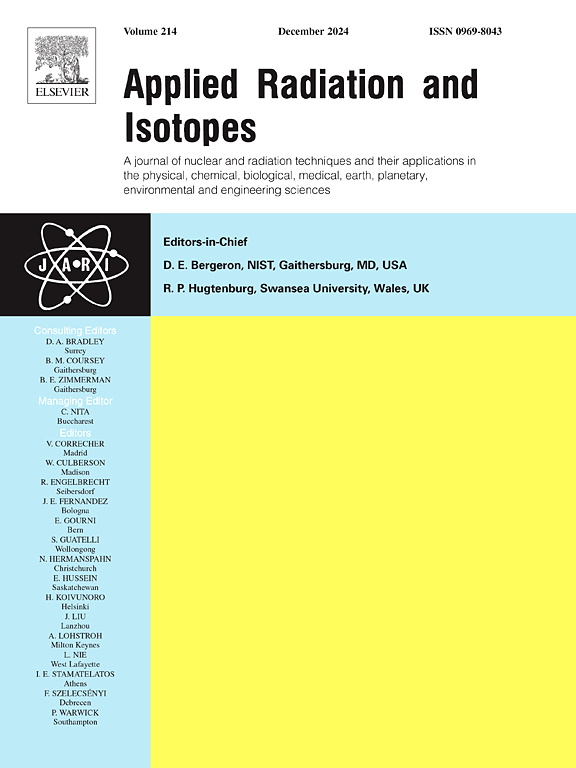68Ga标记葡萄糖衍生物PET探针[68Ga]Ga-NOTA-SDG的合成及生物学评价
IF 1.6
3区 工程技术
Q3 CHEMISTRY, INORGANIC & NUCLEAR
引用次数: 0
摘要
目前,2-[18F]氟-2-脱氧-d -葡萄糖([18F]FDG)已广泛应用于肿瘤的临床诊断。然而,它的应用受到一些限制,包括低肿瘤特异性,需要加速器生产18F,以及复杂的合成过程。本研究利用68Ga标记的放射性示踪剂的优势,设计了一种68Ga标记的葡萄糖衍生物PET分子探针[68Ga]Ga-NOTA-SDG来克服这些问题。方法设计放射性标记前体NOTA- sdg,将靶向基团d -葡萄糖和螯合剂NOTA与丙基甘氨酸连接物偶联。68Ga3+与前体NOTA-SDG在37℃孵育15 min得到[68Ga]Ga-NOTA-SDG。采用高效液相色谱法和放射性检测器研究了[68Ga]Ga-NOTA-SDG在PBS和小鼠血清中的体外稳定性。通过将放射性示踪剂与不同剂量的d -葡萄糖和胰岛素共孵育,研究了[68Ga]Ga-NOTA-SDG进入U87和A549细胞的摄取机制。对不同肿瘤小鼠进行PET成像研究,评价[68Ga]Ga-NOTA-SDG在体内的肿瘤诊断能力。结果15 min内快速获得[68Ga]Ga-NOTA-SDG,放射化学产率(RCY)≥98%,放射化学纯度(RCP)≥99%。该探针在小鼠血清和PBS中表现出2小时的高稳定性。细胞摄取研究表明,[68Ga]Ga-NOTA-SDG进入肿瘤细胞是由葡萄糖转运体介导的,尽管其机制与d -葡萄糖不同。PET显像结果显示[68Ga]Ga-NOTA-SDG在多种肿瘤(U87、A549、PC3和A375)中均有高摄取,可清晰显示肿瘤。此外,与[18F]FDG相比,它在非靶组织中的摄取更低。结论[68Ga]Ga-NOTA-SDG具有作为临床肿瘤诊断的广谱PET显像剂的潜力。本文章由计算机程序翻译,如有差异,请以英文原文为准。
![Synthesis and biological evaluation of a 68Ga-labeled glucose derivative PET probe [68Ga]Ga-NOTA-SDG](https://img.booksci.cn/booksciimg/2025-5/102303587221777476040.jpg)
Synthesis and biological evaluation of a 68Ga-labeled glucose derivative PET probe [68Ga]Ga-NOTA-SDG
Purpose
Currently, 2-[18F]fluoro-2-deoxy-D-glucose ([18F]FDG) has been widely used in clinical diagnostics for tumors. However, its application is hindered by several limitations, including low tumor specificity, the need for accelerator production of 18F, and complex synthesis procedures. In this study, a 68Ga-labeled glucose derivative PET molecular probe, [68Ga]Ga-NOTA-SDG, was designed to overcome these issues with the advantages of 68Ga-labeled radiotracers.
Methods
The radiolabeling precursor NOTA-SDG was designed to conjugate the targeting group D-glucose and the chelator NOTA with a propargylglycine linker. [68Ga]Ga-NOTA-SDG was obtained by incubation of 68Ga3+ and the precursor NOTA-SDG at 37 °C for 15 min. The in vitro stability of [68Ga]Ga-NOTA-SDG in PBS and mouse serum was studied using high-performance liquid chromatography with a radioactivity detector. The uptake mechanism of [68Ga]Ga-NOTA-SDG entry into U87 and A549 cells was investigated by co-incubation the radiotracer with different doses of D-glucose and insulin. PET imaging studies in mice bearing various tumors were performed to evaluate the in vivo tumor diagnostic capability of [68Ga]Ga-NOTA-SDG.
Results
[68Ga]Ga-NOTA-SDG was obtained rapidly within 15 min with radiochemical yield (RCY) of ≥98 % and radiochemical purity (RCP) of ≥99 %. The probe exhibited high stability in mouse serum and PBS over a period of 2 h. Cellular uptake studies demonstrated that the entry of [68Ga]Ga-NOTA-SDG into tumor cells was mediated by glucose transporters, although the mechanism differs from that of D-glucose. PET imaging results indicated that [68Ga]Ga-NOTA-SDG showed high uptake in a variety of tumors (U87, A549, PC3 and A375), enabling clear visualization of the tumors. Moreover, it had lower uptake in non-target tissues compared with [18F]FDG.
Conclusions
[68Ga]Ga-NOTA-SDG has the potential to serve as a broad-spectrum PET imaging agent for clinical tumor diagnosis.
求助全文
通过发布文献求助,成功后即可免费获取论文全文。
去求助
来源期刊

Applied Radiation and Isotopes
工程技术-核科学技术
CiteScore
3.00
自引率
12.50%
发文量
406
审稿时长
13.5 months
期刊介绍:
Applied Radiation and Isotopes provides a high quality medium for the publication of substantial, original and scientific and technological papers on the development and peaceful application of nuclear, radiation and radionuclide techniques in chemistry, physics, biochemistry, biology, medicine, security, engineering and in the earth, planetary and environmental sciences, all including dosimetry. Nuclear techniques are defined in the broadest sense and both experimental and theoretical papers are welcome. They include the development and use of α- and β-particles, X-rays and γ-rays, neutrons and other nuclear particles and radiations from all sources, including radionuclides, synchrotron sources, cyclotrons and reactors and from the natural environment.
The journal aims to publish papers with significance to an international audience, containing substantial novelty and scientific impact. The Editors reserve the rights to reject, with or without external review, papers that do not meet these criteria.
Papers dealing with radiation processing, i.e., where radiation is used to bring about a biological, chemical or physical change in a material, should be directed to our sister journal Radiation Physics and Chemistry.
 求助内容:
求助内容: 应助结果提醒方式:
应助结果提醒方式:


